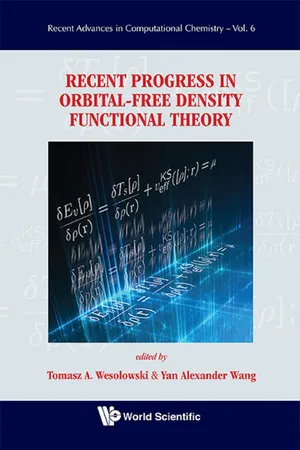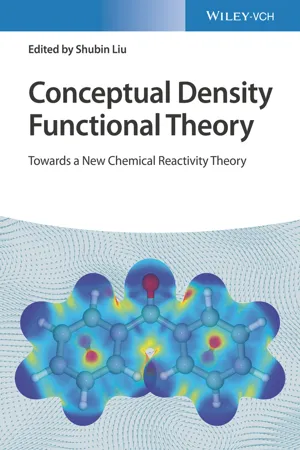Physics
Hamiltonian Density
The Hamiltonian density is a concept in physics that represents the energy density of a system. It is used in the field of quantum field theory to describe the dynamics of fields and particles. The Hamiltonian density is a key quantity in understanding the behavior of physical systems at a fundamental level.
Written by Perlego with AI-assistance
Related key terms
Related key terms
1 of 4
Related key terms
1 of 3
5 Key excerpts on "Hamiltonian Density"
- Tomasz A Wesolowski, Yan Alexander Wang(Authors)
- 2013(Publication Date)
- WSPC(Publisher)
r). As an example, the Pauli potential is given explicitly for the case of harmonically confined independent Fermions.A brief section notes some significant generalizations when the potential V (r) of density functional theory is replaced by the non-local generalization V (r, r′), the most important case of this latter form being Hartree-Fock theory.Contents 3.1 Background and outline 3.2 Fermions in surface regimes: nuclei and simple liquid metals 3.2.1 The nucleon surface density 3.2.2 Brief background on surface energies 3.3 Variational principle for the TF plus von Weizsacker (TFvW) method 3.4 Differential virial theorem and the Dirac density matrix 3.4.1 Relation of the exact DVT to the semiclassical Thomas-Fermi method3.5 Perturbative expansion of Dirac density matrix γ(r, r′) in powers of the given one-body potential V(r)3.6 Complete DFT for harmonically confined Fermions in D dimensions, for an arbitrary number of closed shells 3.6.1 Current experimental focus on many Fermions that are harmonically confined.3.5.1 Stoddart-March series for the kinetic energy density t(r) in three dimensions- eBook - ePub
Conceptual Density Functional Theory
Towards a New Chemical Reactivity Theory
- Shubin Liu(Author)
- 2022(Publication Date)
- Wiley-VCH(Publisher)
r) by performing the following integration:(4.1)where,(4.2)It becomes quite clear that a mapping in betweenv(r)andρ(r)exists. According to the Hohenberg and Kohn [4 ] theorem, an inverse mapping betweenρ(r) and v(r)also exists. This observation lies at the heart of the formal development of DFT. Electron density is a three‐dimensional quantity. Therefore, it becomes convenient to useρ(r)to provide chemically meaningful interpretations [9 ]. The most important aspect ofρ(r)is that one can use it to develop various theoretical models. In this context, conceptual density functional theory (CDFT ) [9 –16 ] represents a major (and among the most celebrated) theoretical framework whereρ(r)is used to understand chemical reactivity.Reactivity of a system could be gauged by its propensity in reacting against an action. The action could be generated by several external factors such as another atom/molecule, external electric/magnetic field, change in temperature or external pressure, catalyst, solvent, and confinement. The response of the system could be measured by reactivity when acted upon by any of the aforementioned external factors. As the Hamiltonian of the given system could be completely defined by fixing the values of N andv(r), one could analyze the change in density or energy by varying N,v(r)or both. In this way, one could understand the change in reactivity. To appreciate the reasoning behind the formulation of CDFT, one can invoke the Hohenberg–Kohn theorem, which provides a recipe of variational optimization of the energy functional E[ρ - eBook - ePub
Problem Solving in Quantum Mechanics
From Basics to Real-World Applications for Materials Scientists, Applied Physicists, and Devices Engineers
- Marc Cahay, Supriyo Bandyopadhyay(Authors)
- 2017(Publication Date)
- Wiley(Publisher)
Chapter 6 Density of StatesThe concept of density of states (DOS), or the number of energy states available for a particle to occupy within the energy range and , is one of the most important concepts in statistical mechanics [1]. The DOS is needed to compute the average value of various physical quantities at equilibrium, and it also appears in the calculation of scattering rates associated with an electron scattering due to microscopic interactions with different entities in a medium. Among many other things, it is also needed to compute the current density due to electrons flowing through a device under bias.The next set of problems illustrates the calculation of the DOS for systems of fermions and bosons either under equilibrium or under steady-state (non-equilibrium) conditions arising from the presence of a finite bias across a device. These problems include a study of the dependence of the DOS on the spatial dimensions of confined systems containing either electron or photon gases.-
*** Problem 6.1 Density of states in quantum confined structures (from three to zero dimensions)Consider the quantum confined geometries shown in Figure 6.1 ; 2D: two-dimensional electron gas (2DEG) or “quantum well” (QW); 1D: one-dimensional electron gas (1DEG) or “quantum wire”; 0D: zero-dimensional electron gas (“quantum dot” or “quantum box”). Calculate the energy dependence of the DOS in these structures at equilibrium and compare them to the three-dimensional bulk sample shown in the upper left corner of Figure 6.1 . Assume a parabolic energy dispersion relation in the lowest conduction band, i.e., , where is the magnitude of the electron wave vector and is the electron's effective mass.
Solution:
- a. 3D:
- eBook - ePub
- Andrey B. Rubin(Author)
- 2017(Publication Date)
- Wiley-Scrivener(Publisher)
r, t), this operator is(24.9)where Δ is the Laplace operator that in Cartesian coordinates is(24.10)Wave function ψ(r, t) will be the product of two functions, one of them depending only on time and the other only on the coordinates:Consequently, the complete wave function of the stationary state of a quantum system is as follows:(24.11)As seen, the complete wave function (Equation (24.11) ) of the stationary state of a quantum system is time-dependent, where value E corresponds to the energy of the given stationary state of the system.Wave functions, obtained from the solution of the stationary Schrodinger equation for a hydrogen atom, are of principal importance in quantum mechanics. The wave function of the ground state of a hydrogen atom most frequently used for estimate calculations is(24.12)Principle of Superposition. An important condition underlying many quantum effects is the principle of superposition of states. This principle is a consequence of the Schrodinger equation as a linear differential equation. According to the theory of differential equations, any sum of particular solutions of a linear differential equation is also its solution. This sum is called a superposition, or linear combination, of partial solutions.In quantum mechanics, the principle of superposition of states is one of the fundamental principles. If a system can be found in states described by wave functions ψ1 , ψ2 , ψ3 - eBook - ePub
- Paola Lecca, Angela Re(Authors)
- 2019(Publication Date)
- CRC Press(Publisher)
the sum of kinetic energy (that of motion) and the potential energy (that of position). In one dimension, the Hamiltonian operator for a particle of mass m is H = − ℏ 2 2 m ∂ 2 ∂ x 2 + V (x) where − ℏ 2 m ∂ ∂ x is the quantum analogue to the classical variable momentum of the particle. The Hamiltonian is a linear Hermitian operator, i.e. give two wave functions Ψ 1 and Ψ 2 H (c 1 Ψ 1 + c 2 Ψ 2) = c 1 H Ψ 1 + c 2 H Ψ 2 for any constants c 1 and c 2 ∈ ℂ, and ∫ Ψ * H Φ d v = ∫ Φ (H Ψ) * d v (1.3) where Ψ and Φ are any twice differentiable functions for which ∫ Ψ*Ψ d v and ∫ Φ*Φ d v are finite. Traditionally, the integrals in Eq. (1.3) are written in the Dirac brackets notations as in the following. 〈 Ψ | H Φ 〉 = 〈 H Ψ | Φ 〉 Finally, for a system governed by a wave function Ψ, the average or the expectation value of any dynamical variable represented by a quantum operator G is 〈 G 〉 = 〈 Ψ | G | Ψ 〉 〈 Ψ | Ψ 〉 (1.4) where 〈Ψ|Ψ〉 = ∫ Ψ*Ψ d v. 1.2 The Time-independent Schrödinger Equation If the Hamiltonian is time independent, the Schrödinger equation can be separated into coordinate- and time- dependent parts. Writing Ψ (x 1, x 2, …, x N, t) = φ (x 1, x 2, …, x N) χ (t) (1.5) we can separate the variables in Eq. (1.2) to obtain − i ℏ d φ d t = E φ (1.6) whose solution is χ (t) = e − i E t ℏ (1.7) and the so called time-independent Schrödinger equation H φ = E φ. (1.8) E is a separation constant whose physical significance is that of an energy. In fact, the time-independent Schrödinger equation, the operation of the Hamiltonian on the wave function produces specific values of the energy, called eigenvalues of H. The wave function to which the Hamiltonian operator is applied is called eigenfunction of H. It is straightforward to prove that the eigenvalue E is the expectation value of the Hamiltonian of the system, i.e. E = 〈 H 〉. Using Eq. (1.5), (1.7), and (1.8), we can evaluate Eq
Index pages curate the most relevant extracts from our library of academic textbooks. They’ve been created using an in-house natural language model (NLM), each adding context and meaning to key research topics.
Explore more topic indexes
Explore more topic indexes
1 of 6
Explore more topic indexes
1 of 4




